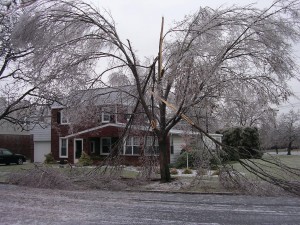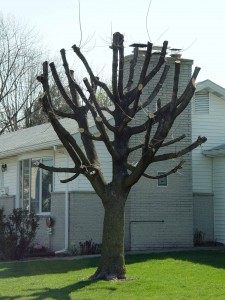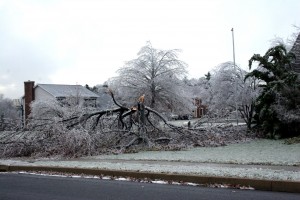Ice Damage to Trees
March 13th, 2008
Rich Wengert of Lebanon thought he’d heard a loud crack outside in the middle of one recent wintry night.
But it wasn’t until he heard chainsaws whirring first thing in the morning that he looked out to see that ice had torn a couple of big limbs off his Chinese elm tree and deposited them in the street out front.
“When I first saw how the tree looked, I thought it was a goner,” he says. “It got hammered pretty good.”
Although this particular elm is a little misshapen and thinner than before, pruning salvaged it.
Lots of other trees haven’t been so fortunate.
This ice-storm-laden winter has literally torn apart thousands of area trees, snapped off many more at the base and even toppled some weak-rooted ones.
The Big Mamma was the Dec. 15-16 icing that resulted in some of the worst hits our power lines have ever taken. Falling and sagging branches caused line damage that rivaled Hurricane Isabel in 2003.
“I never saw an ice storm like that in my lifetime,” said Bob Good, owner of Good’s Tree Care in New Cumberland and Hershey. “You only get one like that every 30 or 40 years.”
The odd thing about ice damage is that it causes selective tree damage that’s related to a variety of factors.
One of them, obviously, is how much icing occurs.
Conditions have to be just right for ice to build up to quantities that cause branches to give way.
Light coatings don’t faze most trees. But at a quarter- to half-inch layer, small branches and weak limbs start to snap, and beyond that, the big ones go.
Sometimes only a fraction of a degree makes the difference between ice buildup and less harmful snow or rain.
“Isolated areas got hit worse than others,” Good said. “There was a couple-block area of Hershey, for example, that was significantly hit. But the other side of Hershey was fine.”
Ditto on the West Shore. Atop and north of Reeser’s Summit, trees took a hit. Just to the south, it mostly rained.
Not much you can do about that.
However, some tree-failure factors can be addressed to make your trees less prone to future ice and wind damage.
Let’s look at what trees ran into ice trouble this winter and why:
* Dead, injured or decayed wood. Compromised wood has little strength, and that was the first to come off under ice or wind load.
Some of this is normal and is nature’s way of cleaning itself.
A better idea is to prune out at least the bigger dead limbs before they drop on you, the house or the power line… and to decipher why and then counteract reasons that the tree is declining.
* Lousy pruning. Untold branches of otherwise sturdy trees were doomed by harmful practices such as “topping,” in which trees are sheared like a shrub. That stimulates a lot of new, weakly attached growth that comes off easily in storms.
Also, if you let behind stubs after pruning, they usually die and lead to rot where they attach to the trunk. Clean them up now.
If you cut flush or into the trunk, you’ll cause wounds that won’t heal. Make any future cuts back to the outer edge of the little rings you’ll see at the juncture.
* Lack of pruning. Don’t assume you’re better off doing nothing. Unpruned trees often have excess branches that clog the tree and rub into one another, opening wounds that lead to decay.
“Trees that are reasonably thinned and well maintained usually avoid trouble,” says Hampden Twp. certified arborist Bob Carey, host of the 11:30 a.m. Sunday “Garden Talk” radio show on Carlisle WIOO-1000AM. “You don’t have all of that excess wood that acts like a sail to collect wind and to catch all of that ice.”
Case in point. Carey saw one West Shore development that had the same mix of locusts, oak and ash throughout. Some were pruned and maintained well, the rest were let go.
“The ones that were pruned well had much less damage,” he says.
Similar trouble: When you allow ivy or other wind- and ice-catching vines and weeds to grow up into trees.
Pin oaks also suffered big-time because ice formed on the browned-out leaves they hold in winter.
* “V-crotches” and other poor training. Arborists lost count of how many trees split where two competing, upright, V-shaped attachments came together.
Think about turkey wishbones. Which are easiest to break… the wide ones or the ones with the sharper “V” angle?
Trees are like children: train them well when young and they grow stronger. That’s the time to eliminate “V’s” as well as multiple branches coming out of the same spot.
“People think about new trees the way they think of a new car,” says Eric Vorodi, owner of About Trees Consulting in Boiling Springs. “They figure they’re going to get the first 50,000 to 80,000 miles trouble-free and assume there’s no reason to do anything. Pruning should be done in the early years to train the tree’s shape. It’s cheaper, too, to have someone come in with a pole saw from the ground than to have to climb up in a tree to make bigger cuts later.”
* Operator error. Most of the blow-overs and snap-offs can be traced to poor planting practices and picking the wrong tree for the spot in the first place.
Among the horticultural horrors that make trees cringe: planting too deeply, not fraying out circling roots before planting, packing mulch up on the trunk, whacking into the bark with mowers and trimmers, planting in compacted and poorly drained soil, giving roots inadequate space to grow (i.e. in those skinny tree lawns between the road and sidewalk) and much more.
“A lot of this is just a wrong-tree, wrong-place scenario,” says Carey. “It goes back to picking the wrong tree for the site and planting it in lousy soil. You can get away with that in marginal situations, but when things get a little extreme, that’s when it’s trouble waiting to happen.”
* Storm-prone species. Some trees are just more prone to breaking than others because of the way they grow.
White pines and ‘Bradford’ pears, for example, proved to be much more brittle and crack-prone than crabapples, dogwoods and hornbeams.
Trees with broad crowns and long branches (i.e. elms, ash and honeylocust) tended to suffer more from the ice load than narrower, more pyramidal trees (i.e. ginkgo, stewartia and most evergreens).
For a list of some of the best snap-resistant, strong-wooded “muscle” tree species, check out this article: https://georgeweigel.net/favorite-past-garden-columns/trees-shrubs/muscle-trees.
SIDEBAR 1
Tree species that took the worst beatings in this icy winter:
* ‘Bradford’ pear
* Willow
* White pine
* Poplar
* Green, mountain and white ash
* Elm
* White birch
* Honeylocust
* Silver and red maples
* Zelkova
* Hackberry
* Boxelder
* Pin oak
* Black locust
* Purple-leaf plum (leaned)
SIDEBAR 2
Trying to figure out whether to keep or cut winter-damaged trees?
Some guidelines from local arborists and the Arbor Day Foundation:
* A large tree is now leaning, and it’s near a house or sidewalk. Remove it ASAP.
* A small or recently planted tree is leaning. Straighten it and stake for a year. Or replant after improving the soil.
* Several large limbs are cracked and hanging. Have them removed ASAP. If 50 percent or more of the canopy is intact, it’s usually worth keeping the tree (although it may never recover its previous form). Watch for signs of rot where limbs came off.
* The leader (main trunk) snapped off. The tree’s not necessarily a goner. Again, it may never look the same, but odds are it’ll recover and continue growing.
* Competing leaders (two trunks in a “V” shape) have split down the middle. A small, partial split can be cabled together by an arborist, but a big split usually is fatal.
* A lot of smaller to mid-size branches broke off. If 50 percent or more of the branches are intact, it’s probably worth keeping. At least wait until the tree leafs out to see if you can live with what’s left until it fills in a bit. Cut any remaining stubs back to where the branch attaches – just to the outer edge of the little rings.
* Just one branch came off, but it was a big one on a mature tree. Usually salvageable. Make a clean cut and watch for signs of decay. If the break exposed widespread decay already taking place, though, it’s probably time to say goodbye.
* Evergreen branches are sticking out here and there. Use a soft material such as old nylons or tree wrap to pull branches back into form, ideally in a way that hides the tie.
* Warning: Any repairs that involve a ladder and/or chainsaw should be handled by a trained arborist!










